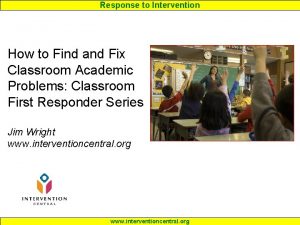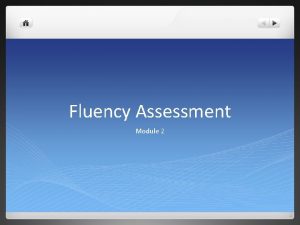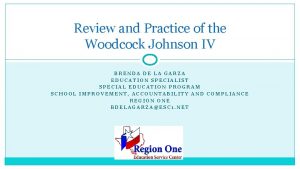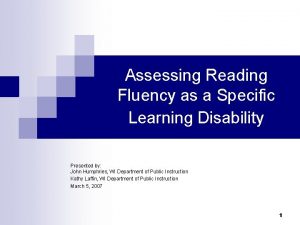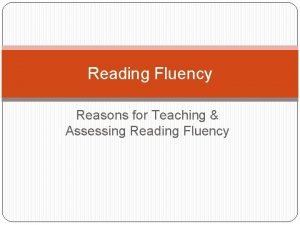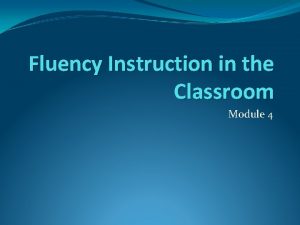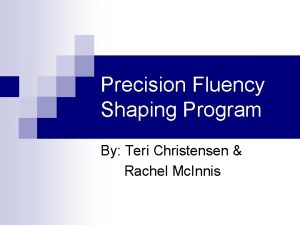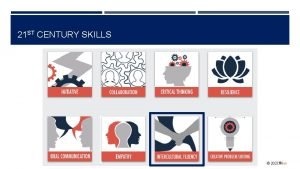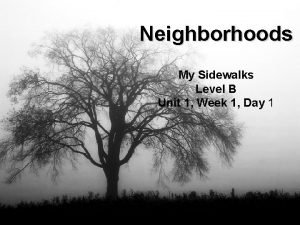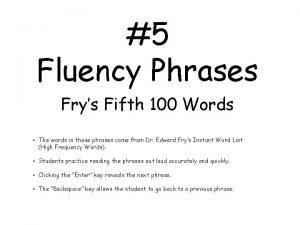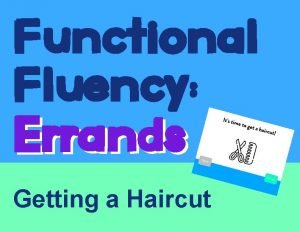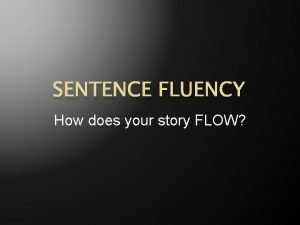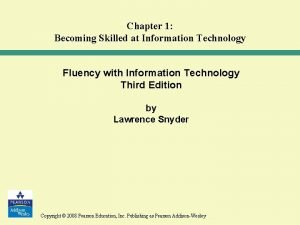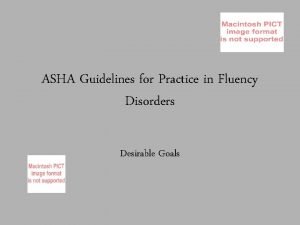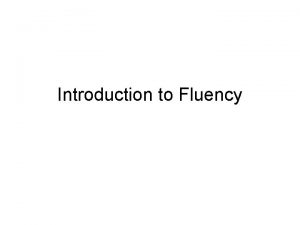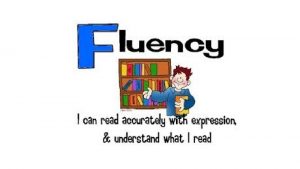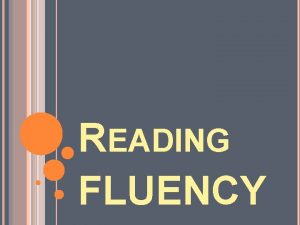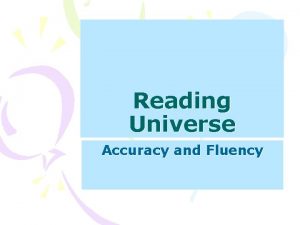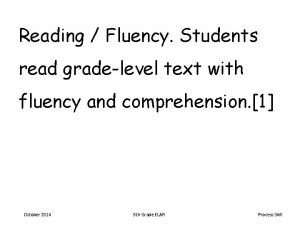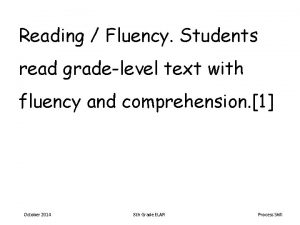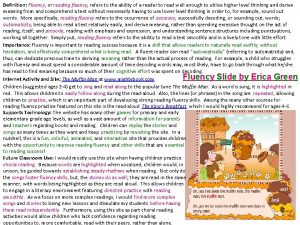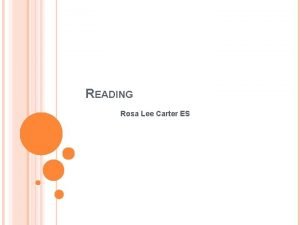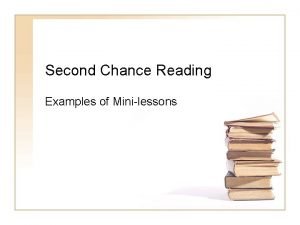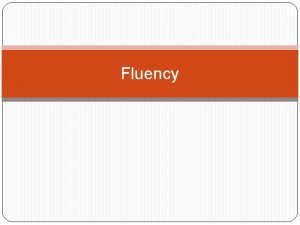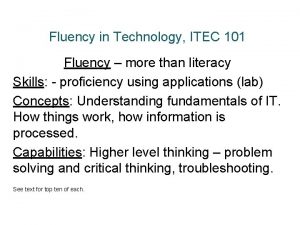Reading Fluency A series of minilessons on the

























- Slides: 25

Reading - Fluency A series of mini-lessons on the six components of becoming a fluent reader. Pausing Phrasing Stress Expression Rate Integration By Jenny Graham

Learning Intention (Why are we learning this? ) • To improve students fluency by helping them understand; pausing, phrasing, stress, expression, rate and integration. • To give students activities specifically related to pausing, phrasing, stress, expression, rate and integration to help them complete a self-assessment and monitor their own reading. Success Criteria (How do we know if we have learnt? ) • Students have a greater understanding of the components of fluency ie. pausing, phrasing, stress, expression, rate and integration • Students have greater fluency when reading. • Students are able to complete a self-assessment. • Students’ reading levels improve.

The Big 5 - Essential Components of Reading preh Com O nc y nics l sfu s e cc er u S ad Re Flu e cus o f ur Pho ensi on Phonemic Awareness y lar V u ab c o

Fluency Learning Progression By Jenny Graham Slide 1 Slide 2 Slide 3 Slide 4 Slide 5 Slide 6 Side 7 Slide 8 Slide 9 Slide 10 Slide 11 Slide 12 Slide 13 Slide 14 Slide 15 Slide 16 Slide 17 Slide 18 Slide 19 Slide 20 Slide 21 Slide 22 Slide 23 Slide 24 Title page Colours indicate Learning Intention and Success Criteria background colour on The Big 5 Essential Components of Reading diagram Learning Progression slide to help find a specific Overview - What is fluency? Oxford dictionary definition of fluent. Fluency moving mind map. fluency component Fluency rubric modified from Fountas and Pinnell Pausing - definition, examples and a picture book Pausing - Understanding of what we as readers need to do for each punctuation mark Phrasing Pausing - example without punctuation (Charlotte’s Web) Stress Pausing - example with punctuation (Charlotte’s Web) Pausing rubric with self-assessment Expression/Intonation Phrasing definition and activities Rate Phrasing rubric with self assessment Integration Stress definition and activity Stress rubric with self assessment Expression/ Intonation definition and why we need to use expression in our reading. Rap song ‘Don’t Read Like a Robot Reader’s Theatre links Expression rubric Rate definition and examples of reading too fast and slow Ideas to help monitor reading rate Fluency rate rubric Reading quote - Dr Seuss Integration - How are you going? Teacher resources

What is fluency? Let us understand the base word fluent. Fluent is an adjective such as ‘You can be clean, late, clever, afraid, fast, fluent. ’ (From Oxford dictionary) Able to express oneself easily and articulately. ‘a fluent speaker and writer on technical subjects’ 1. 1 Able to speak or write a particular foreign language easily and accurately. ‘she became fluent in French and German’ 1. 2(of a foreign language) spoken accurately and with facility. ‘he spoke fluent Spanish’ Smoothly graceful and effortless. ‘his style of play was fast and fluent’ Fluency moving mind map can be found on the twinword website - link here https: //www. twinword. com/ideas/graph/ If you haven’t used twinwords before type fluency in to the LSI graph search and watch words associated with fluency interact. If you hover any word it will give you a definition. Able to flow freely; fluid. ‘a fluent discharge from the nose’ Origin Late 16 th century from Latin fluent- ‘flowing’, from the verb fluere. Pronunciation fluent/ˈfluːənt/ ***************************************** The next slide is a rubric on ‘reading fluency’ using the six dimensions which create a fluent reader. This rubric has A LOT of information as it focuses on each dimension. Give students a brief look now at the overall fluency rubric, however it is also throughout the slides at the end of each component.

*The ‘Six Dimensions of Fluency’ statements are modified from the Fountas and Pinnell Assessment Guide. PAUSING Pausing refers to the way the student’s voice is guided by punctuation (for example, short breath at a comma; full stop with voice going down at full stops and up at question marks) Almost no pausing to reflect Some pausing to reflect the Most of the reading evidences Almost all of the reading is characterised by pausing to reflect punctuation or meaning of the punctuation and meaning of the appropriate pausing to reflect and meaning of the text the punctuation and meaning of the text PHRASING Phrasing refers to the way the readers put words together in groups to represent the meaning. Phrasing reading sounds like oral language, though more formal. No evidence of appropriate Some evidence of appropriate Much of the reading evidences Almost all of the reading is appropriately phrased phrasing during the reading appropriate phrasing STRESS Stress refers to the emphasis students place on particular words (louder tone) to reflect the meaning as they would do when talking. Almost no stress on appropriate Some stress on appropriate Most of the reading evidences Almost all of the reading is characterised by stress on appropriate words to reflect the meaning of stress on appropriate words to reflect the meaning of the text reflect the meaning of the text EXPRESSION Expression refers to the way the student varies their voice in tone, pitch and volume to reflect the meaning. Almost no variation in voice or Some variation in voice or tone Most of the reading evidences Almost all of the reading evidences variation in voice or tone (pitch) to reflect the meaning of variation in voice or tone (pitch) reflect the meaning of the text to reflect the meaning of the text RATE Rate refers to the pace at which a student moves through the text-not too fast and not too slow. Almost no evidence of Some evidence of appropriate Most of the reading evidences appropriate rate during the reading appropriate reading Almost all of the reading evidences appropriate rate INTEGRATION Integration involves the way a reader consistently and evenly orchestrates rate, phrasing, pausing, expressing and stress. Almost none of the reading is Some of the reading is fluent Most of the reading is fluent Almost all of the reading is fluent

Pausing is about understanding the effects of punctuation when we read. Talk with the person next to you about all the types of punctuation you know. Listen to Punctuation Takes a Vacation - picture book written by Robin Pulver https: //www. youtube. com/watch? v=J-fj 9_Ct. TNM If you have 20 Odd Ducks available in your library it would also be a good read at this stage 20 Odd Ducks by Lynne Truss Why every punctuation mark counts! Before progressing to the next slide…. Ask students to discuss what they do as a reader when they see the following punctuation marks , . ! ? “” - ; and when they see print in italics Once they have discussed their answers check on the next slide.

Punctuation and what as readers we do. . comma - pause slightly. full stop - pause long enough to take a breath. Your voice should go down a bit at the end -dash - pause long enough to show the emotion the author is trying to create “ “ quotation marks - These indicate that a character is speaking. You should read as though you are the character and use appropriate emotion italicized print - emphasise the word or words that are italicized Question mark ? Read it as though you’re asking a question’ Make your voice go up at the end Exclamation Point ! - Read it with excitement, surprise, or anger as appropriate. Semicolon ; it connects two related sentences together as one. Pause like a comma. https: //www. ntschools. org/cms/lib/NY 19000908/Centricity/Domain/748/punctuation%20 italics%20 reading%20 act. pdf

Ask a student or all students to attempt to read the following passage taken from the first page of Charlotte’s Web written by E. B. White with all punctuation marks removed. Wheres Papa going with that axe said Fern to her mother as they were setting the table for breakfast out to the hoghouse replied Mrs Arable some pigs were born last night I don’t see why he needs an axe continued Fern who was only eight well said her mother one of the pigs is a runt its very small and weak and it will never amount to anything so your father has decided to do away with it shrieked Fern you mean kill it just because its smaller than the others Mrs Arable put a pitcher of cream on the table dont yell Fern she said your father is right the pig would probably die anyway Fern pushed a chair out of the way and ran outdoors the grass was wet and the earth smelled of springtime Ferns sneakers were sopping by the time she caught up with her father

Ask a student or all students to read the following passage taken directly from the first page of Charlotte’s Web written by E. B. White… “Where’s Papa going with that axe? ” said Fern to her mother as they were setting the table for breakfast. “Out to the hoghouse, ” replied Mrs Arable. “Some pigs were born last night. ” “I don’t see why he needs an axe, ” continued Fern, who was only eight. “Well, ” said her mother, “one of the pigs is a runt. It’s very small and weak, and it will never amount to anything. So your father has decided to do away with it. ” “Do away with it? ” shrieked Fern. “You mean kill it just because it’s smaller than the others? ” Mrs Arable put a pitcher of cream on the table. “Don’t yell, Fern!” she said. “Your father is right. The pig would probably die anyway. ” Fern pushed a chair out of the way and ran outdoors. The grass was wet and the earth smelled of springtime. Fern’s sneakers were sopping by the time she caught up with her father. *note the words away and kill are in italics Discuss the differences when reading the text.

*The ‘Six Dimensions of Fluency’ statements are modified from the Fountas and Pinnell Assessment Guide. PAUSING Rubric Pausing refers to the way the student’s voice is guided by punctuation (for example, short breath at a comma; full stop with voice going down at full stops and up at question marks) Almost no pausing to Some pausing to reflect the Most of the reading evidences Almost all of the reading is characterised reflect punctuation or punctuation and meaning of appropriate pausing to reflect by pausing to reflect punctuation and meaning of the text the punctuation and meaning of the text Students independently read a levelled text appropriate to their stage of development focusing on pausing. Once they have read a passage from their levelled text ask them to think about where they would place themselves on the above ‘Fluency-Pausing Rubric’ **You may like to print out individual copies for students. **In the resource section is a list of websites that have passages which can be used for fluency

Phrasing Definition of the base word phrase - Informally, a phrase is a group of words in a sentence that functions somewhat like as single word. For example the house at the end of the street Definition from http: //encyclopedia. kids. net. au/page/ph/Phrase More examples of phrases in link http: //www. fcrr. org/documents/sca/G 4 -5/45 FPart. Two_Phrases. pdf The activity in the PDF can be printed off for students to practice reading simple short phrases. Phrasing therefore helps readers group words together as in normal speech and becoming fluent in their reading. To help with phrasing students can practice reading a passage several times so they are aware of words to group together. See activity below http: //www. fcrr. org/documents/sca/G 2 -3/2 -3 Fluency_3_Phrases. pdf

Phrasing - rubric Students independently read a levelled text appropriate to their stage of development focusing on phrasing. Once they have read a passage from their levelled text ask them to think about where they would place themselves on the above ‘Fluency-Phrasing Rubric’ **You may like to print out individual copies of the rubric for students. **In the resource section is a list of websites that have passages which can be used for fluency PHRASING Rubric Phrasing refers to the way the readers put words together in groups to represent the meaning. Phrasing reading sounds like oral language, though more formal. No evidence of Some evidence of Much of the reading Almost all of the reading is appropriately appropriate phrasing evidences phrased during the reading appropriate phrasing

Stress **What do we think of when we use the word STRESS? Discuss. We tend to think of worrying over something and the worry becomes heightened. Definition from https: //www. outofthisworldliteracy. com/the-6 -characterisitcs/ This refers to the emphasis readers place on particular words. They read a more important word louder to reflect the meaning of that word. They notice important words and put an emphasis or a stress on them when reading aloud. Students who struggle with fluency often read in a more monotone voice. The activity on this link looks at the main words in a sentence and the meaning we gather from a few key words. (You will need to scroll down for the activity - it has audio included) https: //www. englishclub. com/pronunciation/sentence-stress. htm

Let’s look at placing stress on different words in the following sentence I didn't say we should kill him. , Depending on the word capitalised changes the meaning of the word. I didn't say we should kill him. (Someone else said it, not me) - The I is highlighted in this sentence. I DIDN'T say we should kill him. (Stronger, angrier denial) I didn't SAY we should kill him. (But I implied it, wrote it, or whispered it. ) I didn't say WE should kill him. (You should kill him, or someone else. ) I didn't say we SHOULD kill him. (We must kill him, or we shouldn't kill him. ) I didn't say we should KILL him. (We should fire him, or something else. ) I didn't say we should kill HIM. (It should be someone else. ) https: //www. commonsense. org/education/lesson-plans/its-not-what-you-say-its-how-you-say-it-sentence-stress

STRESS Rubric Stress refers to the emphasis students place on particular words (louder tone) to reflect the meaning as they would do when talking. Almost no stress on Some stress on Most of the reading Almost all of the reading is characterised by stress on appropriate words to evidences stress on appropriate words to reflect the meaning of the text reflect the meaning of appropriate words to the text reflect the meaning of the text Students independently read a levelled text appropriate to their stage of development focusing on stress. Once they have read a passage from their levelled text ask them to think about where they would place themselves on the above ‘Fluency-Stress Rubric’ **You may like to print out individual copies for students. **In the resource section is a list of websites that have passages which can be used for fluency

Expression (this may also be called Intonation) Definition intonation from https: //www. vocabulary. com/dictionary/intonation Even if your friend claims she’s not upset by the death of her pet iguana, her intonation may tell a different story. Intonation means the way someone’s voice rises and falls as they’re speaking. Your emotions, your regional accent, or just the particular way you're used to speaking can all affect the intonation of your voice. There's something musical in the way people speak, and intonation describes that musicality. The word also means "producing musical tones, " either with your voice or a musical instrument. Another kind of intonation is chanting, or half-speaking, half-singing your words. Why do you think we need expression when we are reading? How does it help the audience? Discuss. To express a text well, to read it with feeling that matches what it means, is one of the best ways to understand it. In order to match the proper expression to each word or phrase, you have to understand both the meaning of the words and the grammar of each sentence. Expression is such a powerful comprehension strategy because it instantly increases your access to meaning as you read. From https: //www. ttms. org/say_about_a_book/expression_equals_comprehension. htm Don’t Read Like a Robot by Go Noodle - rap song about reading with expression https: //www. youtube. com/watch? v=xjt. PMiumix. A&list=RDxjt. PMiumix. A&start_radio=1&t=109

Practice, practice! ● Reader’s Theatre ● Drama ● Role Play different emotions ● Re-read passages to understand expression to be used Reader’s Theatre - links to websites which offer Reader’s Theatre http: //www. teachingheart. net/readerstheater. htm https: //www. thewiseowlfactory. com/readers-theater-free/ http: //www. thebestclass. org/rtscripts. html https: //www. superteacherworksheets. com/readers-theater. html http: //www. aaronshep. com/rt/RTE. html https: //www. readingrockets. org/strategies/readers_theater

Expression Assessment Students record themselves reading on an i. Pad or on one of the following apps Garage. Band, Quick. Voice Recorder or Voice Recorder and listen to themselves to hear their expression and assess how expressive they feel they read. EXPRESSION Expression refers to the way the student varies their voice in tone, pitch and volume to reflect the meaning. Almost no variation Some variation in Most of the reading Almost all of the reading evidences variation in in voice or tone (pitch) evidences variation voice or tone (pitch) to reflect the meaning of (pitch) to reflect the in voice or tone the text meaning of the text (pitch) to reflect the meaning of the text

Rate refers to the pace/speed in which a reader reads. Reading too fast Look at the short videos on this link which highlights reading too fast https: //blog. allaboutlearningpress. com/child-reads-too-fast/ Reading too slow (word for word) Discuss what you think happens when a reader reads too slow. Do you think they understand the MEANING of what they are reading?

To improve your reading rate: use high frequency word lists recording yourself reading timing yourself reading (remember it is not a race) reading lists of common letter groups such as prefixes, suffixes and syllables https: //fcrr. org/documents/sca/G 4 -5/45 FPart. One_Word_Parts. pdf And have a great understanding of your basic sound-letter combinations https: //fcrr. org/documents/sca/G 2 -3/2 -3 Fluency_1_Letter_Sound_Correspondence. pdf

Fluency - RATE Rate refers to the pace at which a student moves through the text-not too fast and not too slow. Almost no evidence of Some evidence of Most of the reading Almost all of the reading evidences appropriate rate during evidences appropriate the reading rate Students independently read a levelled text appropriate to their stage of development focusing on rate. Once they have read a passage from their levelled text ask them to think about where they would place themselves on the above ‘Fluency-Rate Rubric’ **You may like to print out individual copies for students. **In the resource section is a list of websites that have passages which can be used for fluency

Read, read, read and read some more. Read books, recipes, signs, jokes, games, cartoons, lists and messages. Read everything. Every word you read is getting you one step closer to being a ‘fluent reader’.

INTEGRATION Integration involves the way a reader consistently and evenly orchestrates rate, phrasing, pausing, expressing and stress. Almost none of the Some of the reading Most of the reading Almost all of the reading is fluent Ho w No are y wt ou h do you at you going flue thin und ? n k t Wh ly? you ersta at a are nd f on? rea luen do din c Wh you g m y, at a still ore rea lly w rea do wa nt t ell? you ow thin ork ky ou do

Teacher Resources: Reading passages http: //www. idealconsultingservices. com/FORMS/Data%20 Meeting%20 Forms/Fluency_Level_2_Passages. pdf https: //www. fusd 1. org/cms/lib 03/AZ 01001113/Centricity/Domain/375/Fluency%20 Practice. pdf *RAZ is reading app/website which is a paid subscription but also has great levelled reading passages Fluency Tasks - free printable resources useful for Literacy Centres Foundation/Level 1 Fluency tasks http: //www. fcrr. org/resources_sca_k-1. html Level 2 - 3 Fluency tasks http: //www. fcrr. org/resources_sca_2 -3. html Level 4 -5 Fluency tasks http: //www. fcrr. org/resources_sca_4 -5. html https: //www. lewispalmer. org/cms/lib 010/CO 01900635/Centricity/Domain/1063/Fluency%20 Passages. pdf
 Reading fluency checklist
Reading fluency checklist Intervention central reading fluency
Intervention central reading fluency Cbm reading fluency passages
Cbm reading fluency passages Woodcock johnson iv ordering
Woodcock johnson iv ordering Definition of reading fluency
Definition of reading fluency Reading accuracy
Reading accuracy Fluency oriented reading instruction
Fluency oriented reading instruction While reading activities
While reading activities Shunt series amplifier
Shunt series amplifier Taylor vs maclaurin
Taylor vs maclaurin Arithmetic series vs geometric series
Arithmetic series vs geometric series Series aiding and series opposing
Series aiding and series opposing Maclaurin polynomial
Maclaurin polynomial Maclaurin series vs taylor series
Maclaurin series vs taylor series Ibm p series server
Ibm p series server Heisenberg 1925 paper
Heisenberg 1925 paper Teri christensen
Teri christensen Intercultural fluency
Intercultural fluency My sidewalks level b unit 2 week 5 fluency sentences
My sidewalks level b unit 2 week 5 fluency sentences Fry's fluency phrases
Fry's fluency phrases Functional fluency
Functional fluency What is sentence fluency
What is sentence fluency Precision fluency shaping program
Precision fluency shaping program Information technology fluency
Information technology fluency Fluency friday
Fluency friday Fluency shaping goals
Fluency shaping goals

